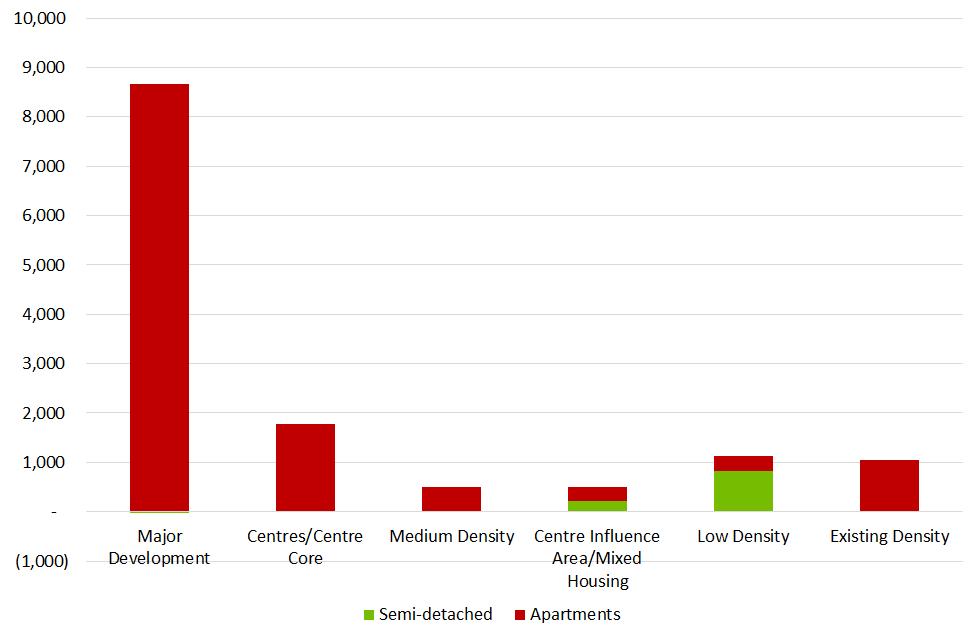
4 minute read
FIGURE 16 HOUSING GAP ANALYSIS APPROACH OVERVIEW
4. SUPPLY
Canada Bay possesses a diverse range of residential neighbourhoods and centres, which support a variety of dwelling types. In order to inform the future planning for housing in the LGA, a comprehensive analysis of Canada Bay’s residential areas has been undertaken. The purpose of this section is to provide an understanding of the LGA’s established housing areas and major development ‘planned precincts’ – leading to an analysis of where future growth may be accommodated.
Advertisement
4.1 Approach
A key element of planning for housing is the need to identify capacity for additional dwelling growth and how this aligns with the scale, type and location of projected housing demand. The likely future housing growth distribution for additional housing was identified using an approach, which can be broadly summarised in three stages: housing demand analysis, housing capacity; and housing take-up. The steps taken in this approach are summarised in the diagram below.
FIGURE 16 HOUSING GAP ANALYSIS APPROACH OVERVIEW
This approach considers demand, supply and likely future take-up of capacity within the context of the current planning framework and policies. It also acknowledges the intertwined nature of demand and supply, including the imperfect nature of the housing market. This modelling helps understand, at a high level, the locations where there may be major differences between demand and supply, in order to underpin policy development and potential changes to planning controls to meet future housing needs. In Section 3, we reviewed the demand component of the equation to gain an understanding of who we are planning for, how many of us there will be and what types of dwellings are likely to be required. This section turns the attention to whether the established stock of housing and capacity within the current planning framework for additional housing to be provided in the LGA meets future housing demand requirements. It also investigates where opportunities and constraints for future growth based on changes to the planning framework may be achieved. Section 5 then completes the gap analysis picture by aligning demand and capacity to understand how and where take-up will occur across the LGA.
4.2 A profile of the City of Canada Bay
Gateway to the Central City Gateway to the Central City Gateway to the Central City Gateway to the Central City
The City of Canada Bay is located in the Inner West of Sydney, in close proximity to the Sydney CBD. This geographic position reflects its function as a gateway between the rapidly developing Central City (surrounding Parramatta) and the more established eastern District (including the Sydney CBD). Canada Bay LGA currently provides homes for approximately 92,000 residents (ABS ERP) across the suburbs of Concord, Canada Bay, Drummoyne, Five Dock, Rhodes, Breakfast Point and Strathfield. There is some significant variation in the suburbs of the LGA in terms of the size, built form, population and development potential characteristics. But overall, Canada Bay is an established municipality; which means there is less vacant land for development so any new development that occurs, whether it be residential, industrial, commercial, institutional or public open space, often requires the redeployment of residual employment land within the LGA for another use.
Mix of employment and residential land uses Mix of employment and residential land uses Mix of employment and residential land uses Mix of employment and residential land uses
The City currently contains a mix of residential, commercial, industrial and other land reserved for public/community uses. Over the past few decades, however, much of the LGA’s employment lands have been turned-over to residential land uses. Logically (and further to the point in the paragraph above), this rapid rate of urban renewal cannot be sustained in the same manner indefinitely, even though in the short to medium term the proposals for the transformation of the Parramatta Road corridor will lead to this trend continuing. Once the remaining urban renewal precincts are developed, further residential change within the LGA would therefore need to consider accessible locations within the established areas of the City. This report provides an analysis where those opportunities may lie.
Well Well Well Well--connected transport networks connected transport networks connected transport networks connected transport networks –––– particularly in the west particularly in the west particularly in the west particularly in the west
There is an established network of centres distributed across the LGA comprising a range of higher-order centres along with some smaller local centres. The City of Canada Bay is also generally well serviced by active, private and public transport: Major roads providing connections through the city include the Parramatta Road, Homebush Bay Drive and Victoria Road. Railway stations at Rhodes, Concord West and North Strathfield. There is also the potential for three Sydney Metro West stations to be located in the LGA, potentially turning either Concord West or North Strathfield into a major transport interchange hub as well as along Parramatta Road and at Five Dock. The suburbs located within the east of the LGA do not (currently) have easy access to the rail services and are therefore largely reliant on bus services for public transport access. Figure 17 below compares different suburbs across the LGA in terms of public transport access. Blue patches indicate strong public transport access, green moderate and yellow poor. A higher weighting is given to station access than bus stop access, as more residents are likely to utilise the rail network frequently than the bus network. The map shows that presently, the western third of the LGA possesses strong public transport access, with three railway stations at Rhodes, Concord West and Strathfield North. Most of the LGA is coloured in a shade of green, indicating reasonable access – mostly through connecting bus services. This pattern could shift slightly when Sydney Metro West’s proposed station locations in the LGA are confirmed.



